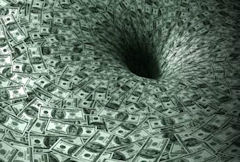Rejoice! The fiscal cliff has been averted.
Fret! There is more political turmoil to come as Washington mud wrestles with sequestration spending cuts and the cap on federal borrowing in the next two months.
Despair! Washington’s inability to enact serious budget reform means that Boomergeddon, once only a strong probability, is now a virtual certainty. The fiscal canyon looms in the mid-term future.
Congress has passed legislation that will raise an estimated $737 billion in new revenues over the next 10 years — less than a single year’s budget deficit — mainly by hiking the income tax on couples making $450,000 or more and by letting the payroll tax expire. The payroll tax was always seen as a temporary stimulus measure, so those revenues cannot properly be counted toward a long-term deficit resolution. At the same time, Congress offset some of its anticipated revenue gains from taxing the rich by dispensing $77 billion in tax loopholes for lobbies ranging from Wall Street banks and NASCAR racetracks to Hollywood film makers and Native American tribes.
Oh… and the deal provided no spending cuts!!
Meanwhile, the federal government will continue to run $1 trillion-a-year budget deficits, despite happy babble that it is destined to decline to a mere $600 billion to $700 billion within 10 years (a level that would have been regarded as obscene and unsustainable only a decade ago).
The happy-talk projections will never materialize, for they are based upon an economic forecast that assumes another 10 years of steady economic growth — on top of the previous three-and-a-half years of economic recovery. In other words, the claims of Washington officialdom that deficits will diminish by the end of the decade assume that the U.S. will have achieved at least 13 1/2 years of uninterrupted economic growth, even though the longest economic expansion in United States history lasted only nine years and the average expansion since World War II has been only five years.
Indeed, Washington’s fantasy-land projections are predicated upon the proposition that economic growth will rebound from its current 2.0%-or-so rate to 4.0% by 2014 and 2015. Somehow, the rate of economic growth is expected to double despite the fact that the nation is already running the most aggressive fiscal-monetary stimulus since World War II. The Federal Reserve Board has already driven real interest rates down to zero. How much lower can they go?
The Fed’s super-stimulative rate policy is goosing the current, less-than-adequate growth rate faster than it otherwise would be, but it sets a booby trap for future growth. As Martin Feldstein explains in today’s Wall Street Journal, the Fed’s purchase of bonds and mortgage-backed securities have put $1.4 trillion more reserves into the hands of commercial banks than legally required. At present, the banks are content to leave that money at the Fed in exchange for a low rate of interest. But if the economy actually shows signs of life, they will begin lending again…. with the result that inflationary pressures will build. Unless Ben Bernanke has discovered a monetary perpetual motion machine, the Fed will face the decision either of tolerating higher inflation, which is bad for economic growth, or raising the interest rate, which is bad for economic growth…. and even worse for federal deficits.
You see, when the nation carries more than $16 trillion in debt, increasing interest rates by a single percentage point implies an increase in interest payments of $160 billion a year. (Insofar as some of the debt consists of a mix of short-, medium- and long-term notes, the full impact may take several years to be felt. But the increase in interest payments will be inexorable.) When the nation continues to pile up deficits at the rate of $1 trillion a year, reaching $20 billion in another four years, a one percentage-point increase will add $200 billion a year to the deficit by the next presidential term — that’s far more than we can possibly cut programmatic spending.
When faced with such a dilemma, the political class is most likely to tolerate higher inflation because it erodes the burden of the national debt and takes them off the hook… for a time. But that is a short-term expediency at best, for investors will not long tolerate the silent expropriation of wealth. They will demand higher interest rates to compensate for the inflation, or capital will flee the country. Meanwhile, inflation will distort the allocation of capital, creating even more havoc. Pick your calamity. There is no free lunch. There is no way out. Boomergeddon is coming.
Bacon’s bottom line: What does this mean for public policy in Virginia? It means that we must deal with continued turmoil in Washington as national politicians try desperately to wriggle out of the ropes with which they have bound themselves. While national leaders may delay the reckoning for a decade or more, the collapse of federal government finances is pretty much foreordained now. Virginia has a few years to brace itself for the inevitable storm, which will entail national economic chaos and massive federal spending cuts — cuts that will fall disproportionately on the commonwealth.
Virginia’s leaders are understandably focused right now on sequestration spending cuts, mandated by previous budget negotiations, which will eviscerate defense spending. This immediate crisis cannot be ignored. But our leadership cannot neglect the long-term structural reforms of our broken institutions — K-12, higher ed, health care, transportation and land use — without which we cannot sustain our global economic competitiveness. Sadly,Virginia’s political class shows no more signs than Washington’s political class of understanding, much less dealing with, the fundamental issues before them.
I’m thinking this is looking like a good hedge right now.



